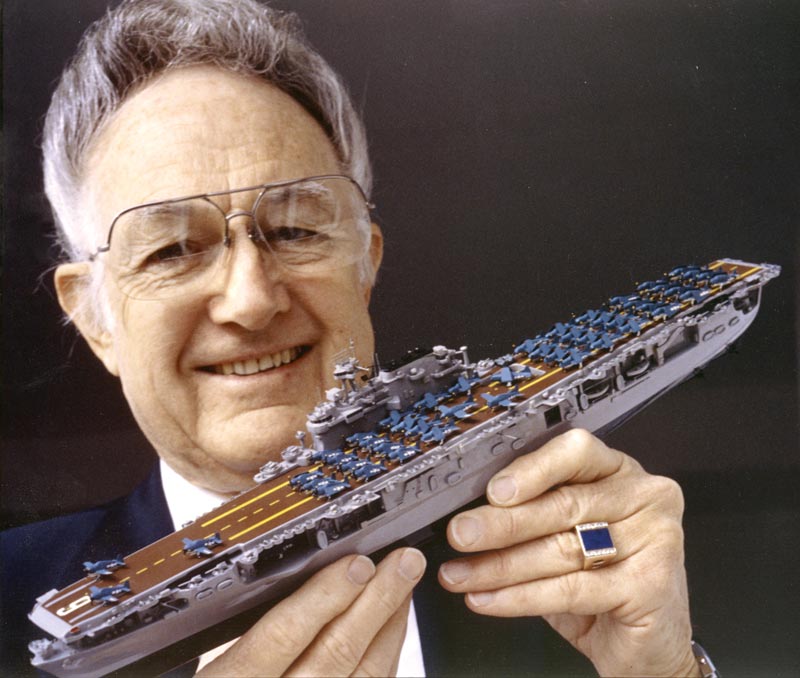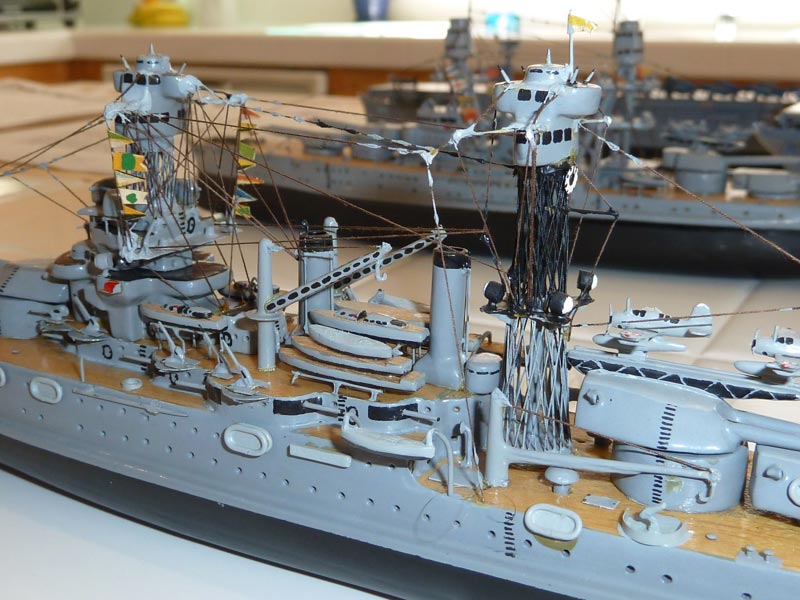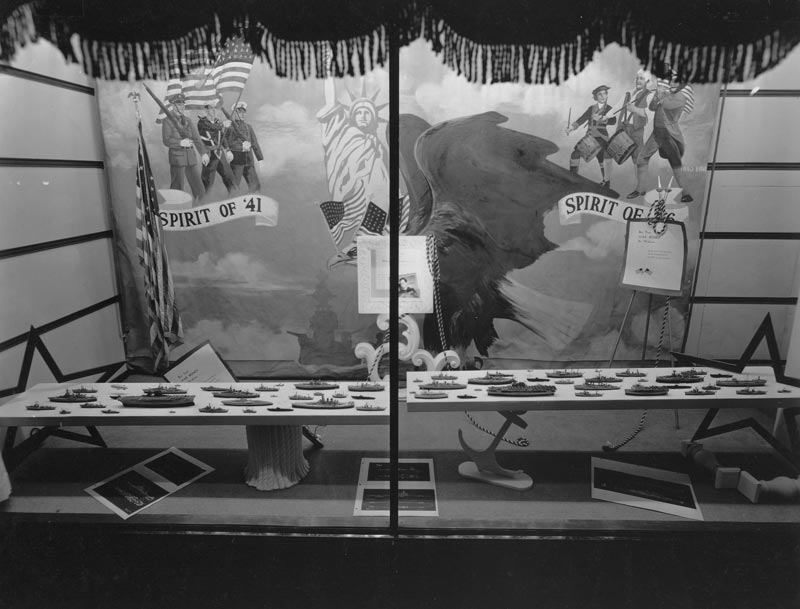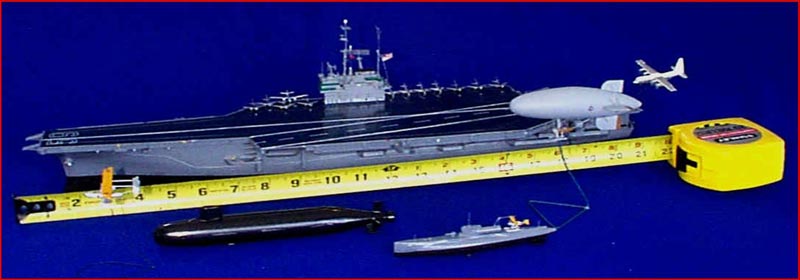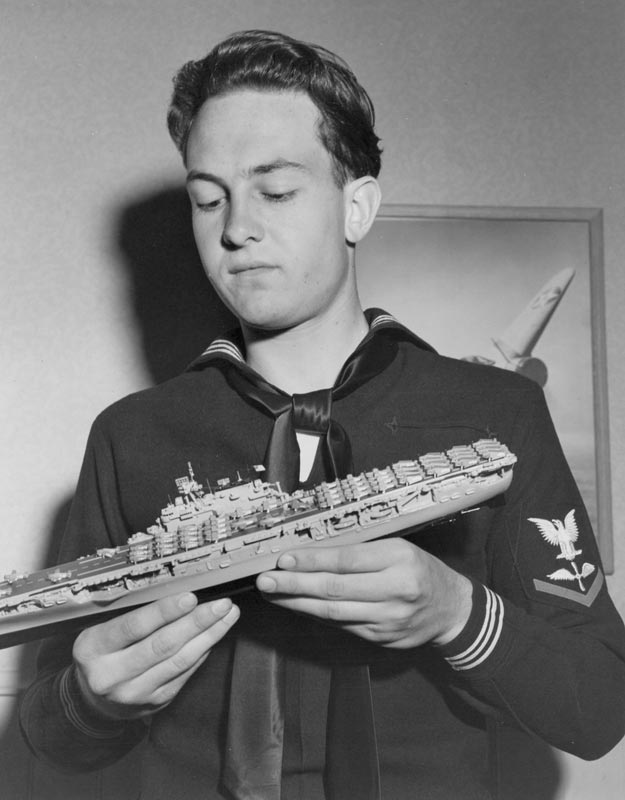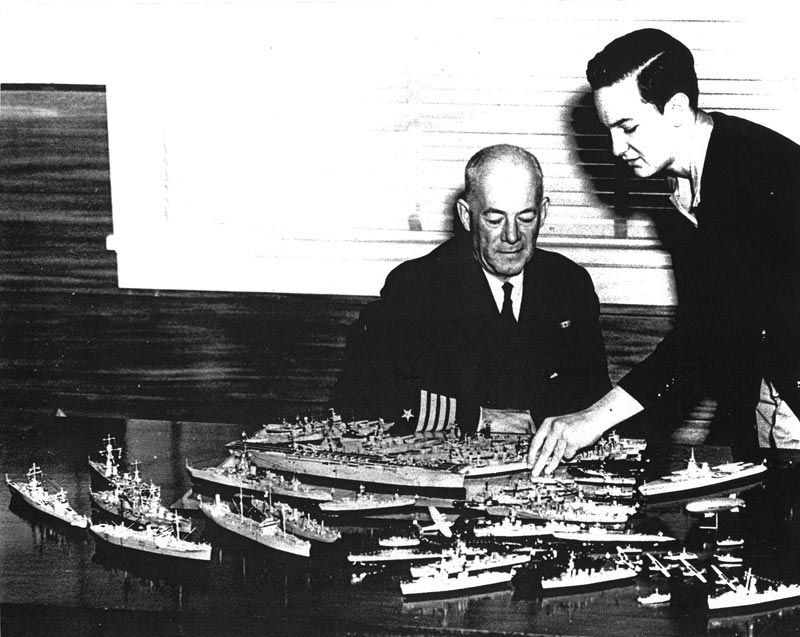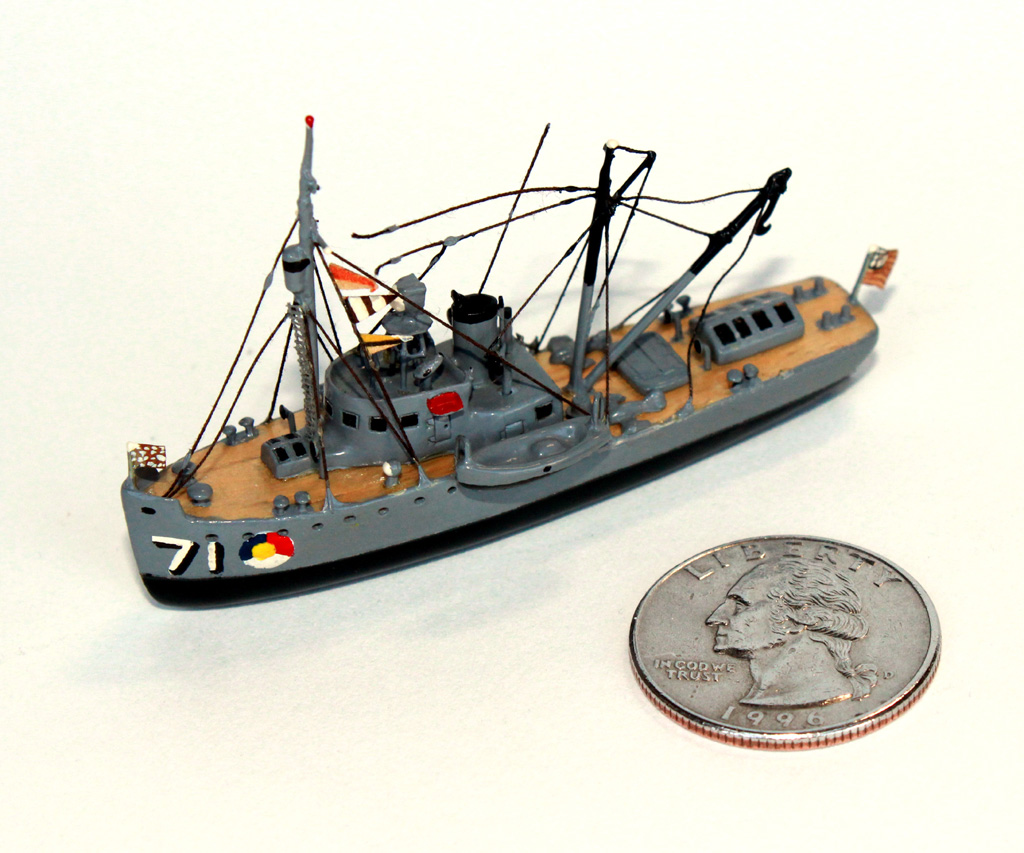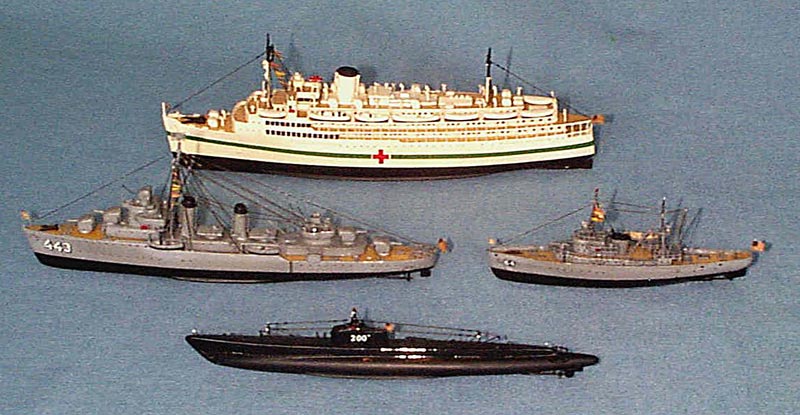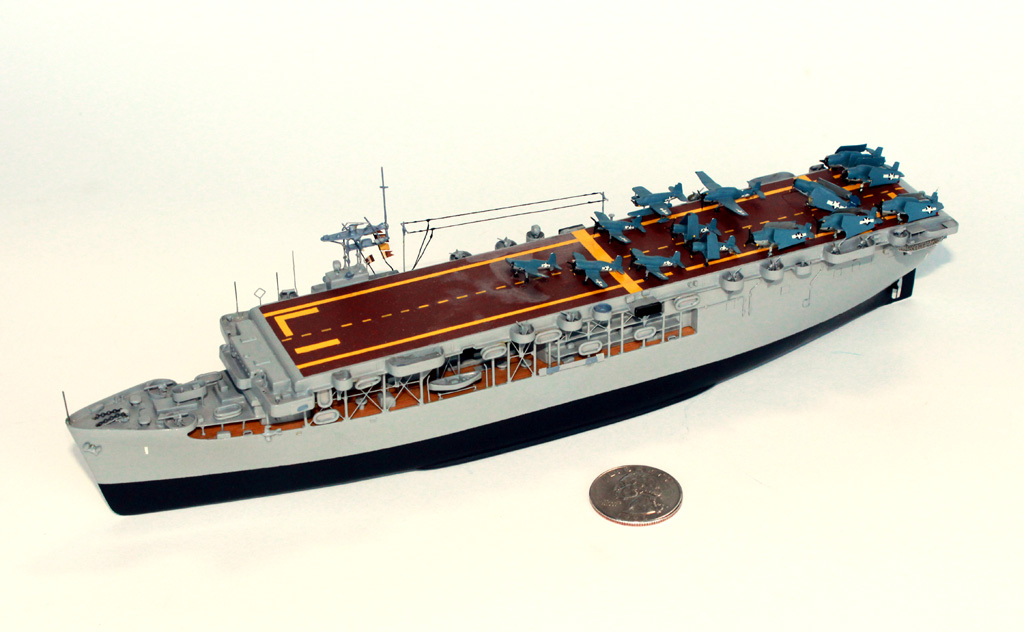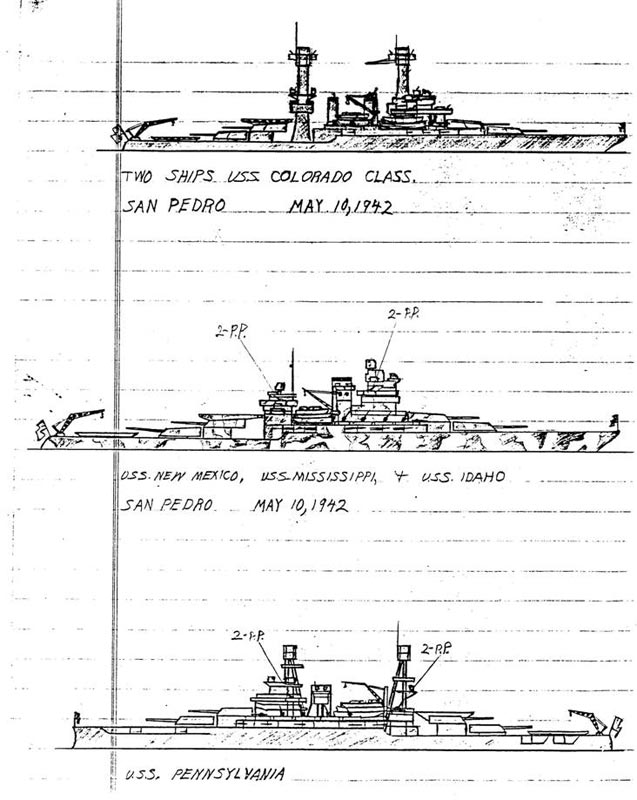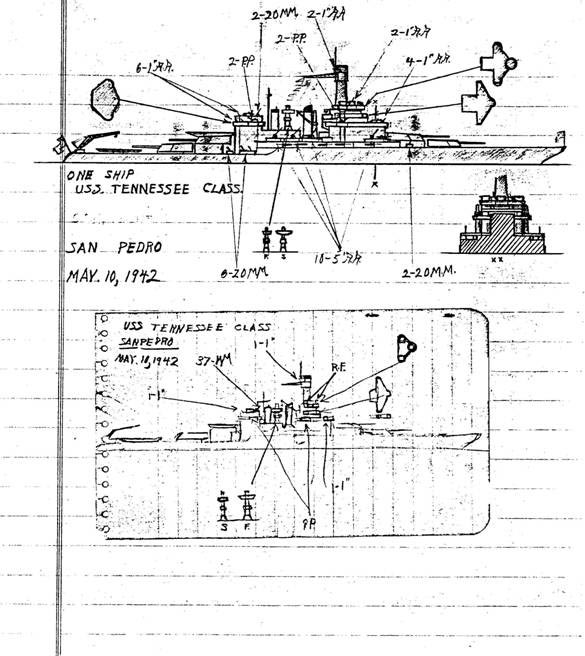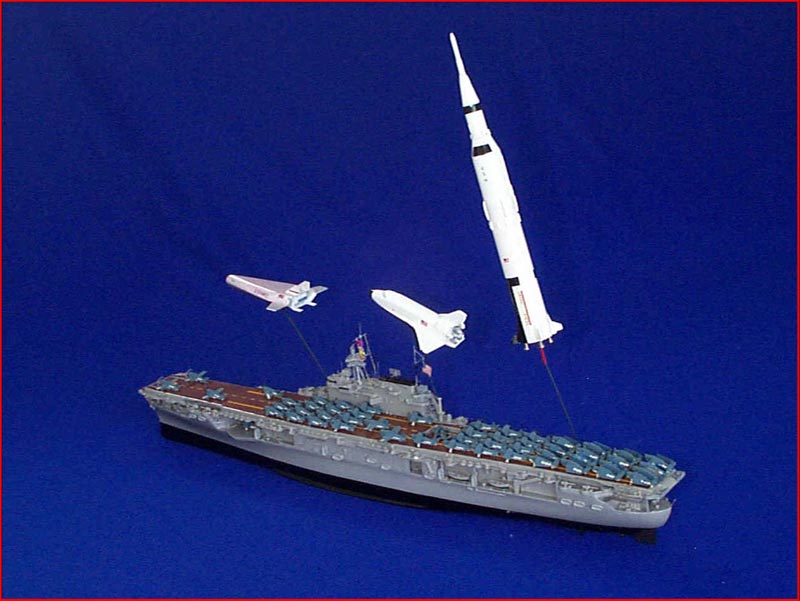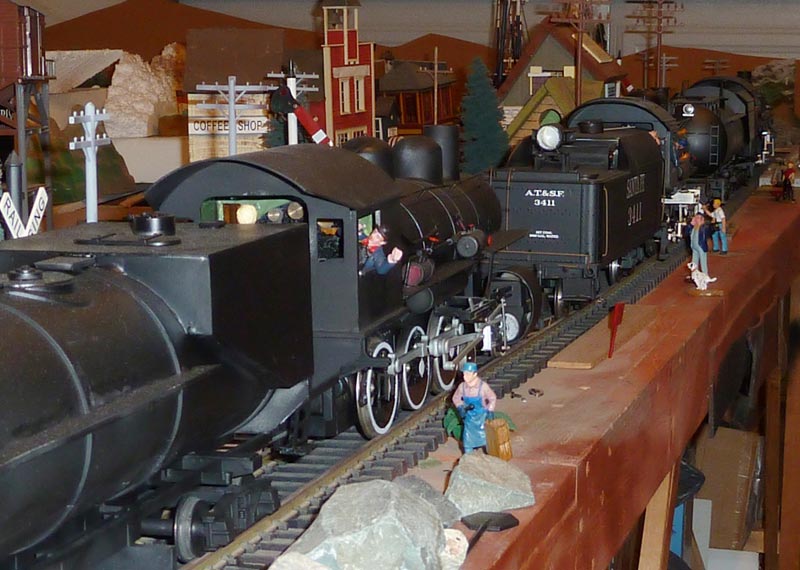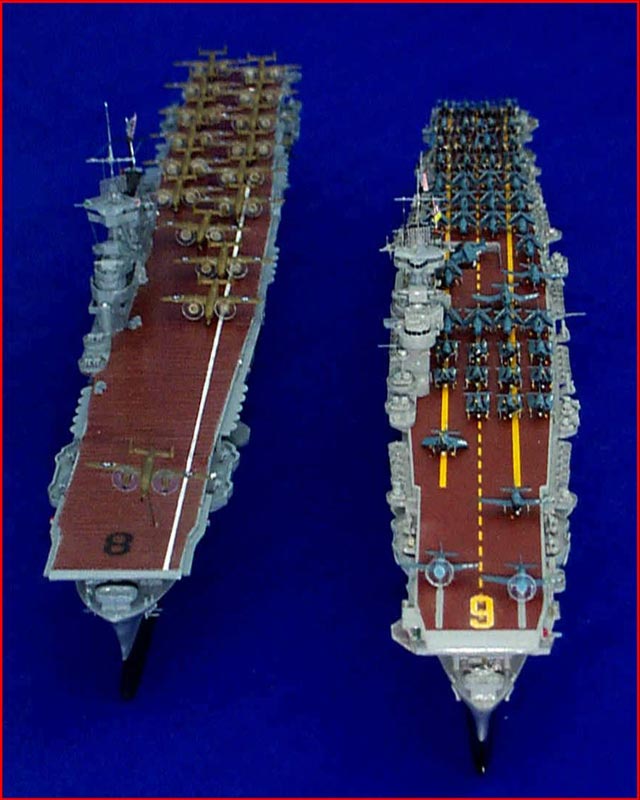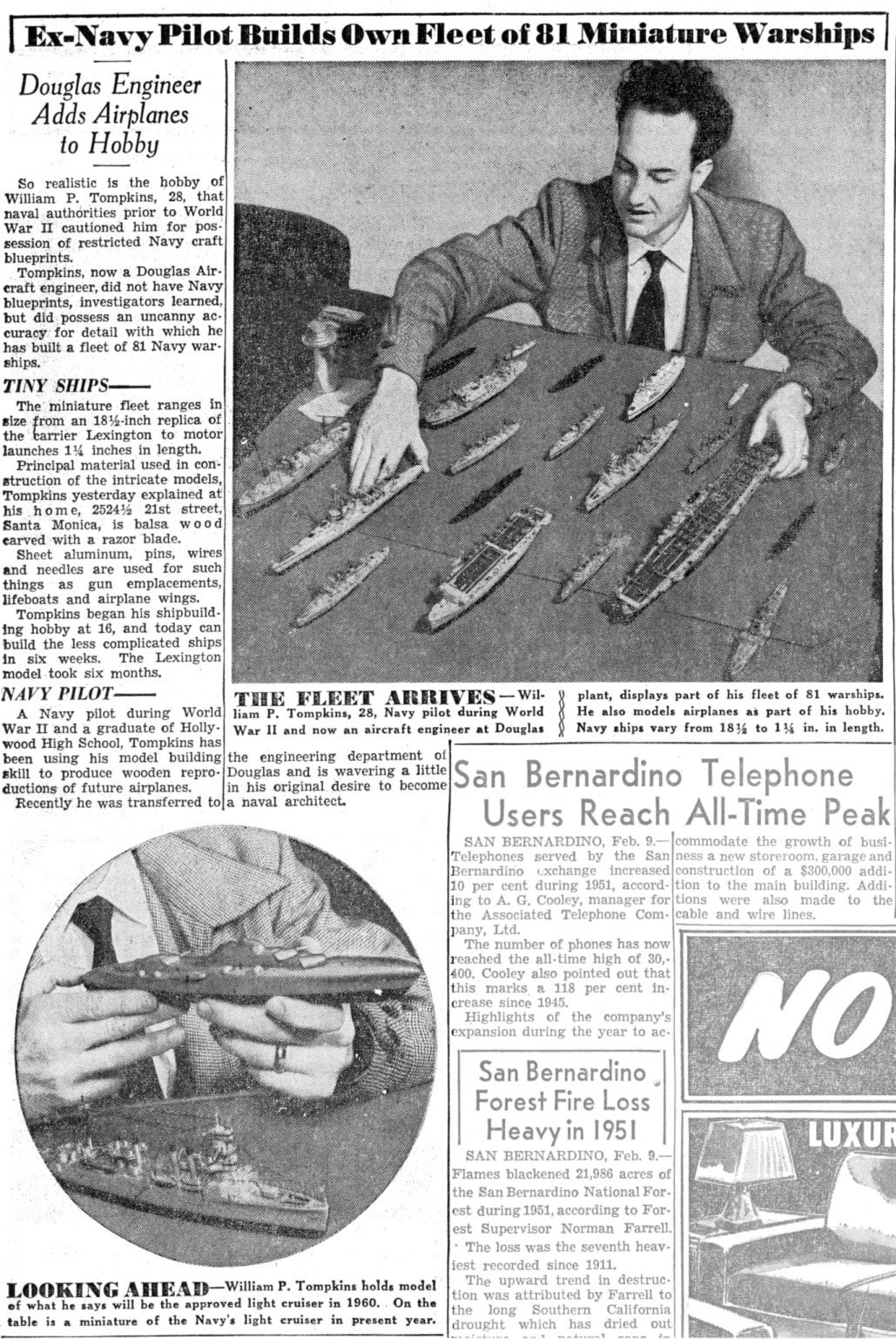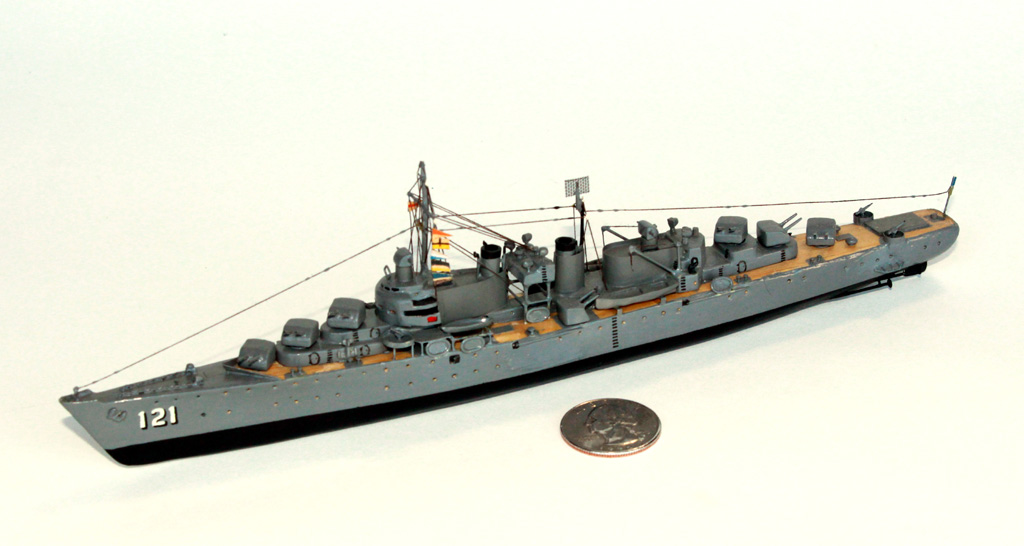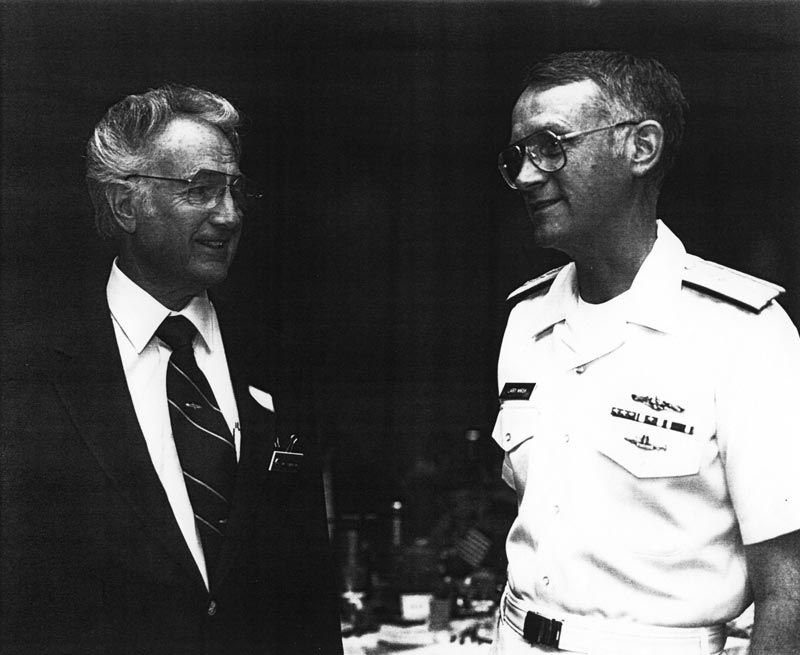May 29, 1923—August 21, 2017
A Lesson in Naval History at 1/600 Scale
William Tompkins of Oceanside, CA displaying one of 307 model ships in his fleet. A modeler from the age of 9, he started in earnest in his teens. Over time, William built an entire fleet that illustrates American Naval history.
A Student Attracts Military Attention With Ship Model Fleet
On March 26, 1941, the Evening Outlook newspaper of Santa Monica, CA published an article that featured a young 17-year-old William Tompkins. In the publication, there was a photo of William displaying over 50 model ships, which he began building at age 9, for a US Navy Captain. Captain G.C. Gearing was the commandant of the 11th Naval District in San Diego, and he was not the only one in the Navy interested in Bill’s models.
Rear Admiral C.A. Blakely, who examined the models, was quoted in the article as saying, “It is with considerable interest and pleasure that I, together with officers of my staff, examined several of the ship models. Craftsmanship such as you have evidenced shows that you are a keen student of detail and naval construction.”
Rear Admiral Blakely continued, “Best of all, however, you are doing something worthwhile as a young American—you are helping to build into the American mind the importance of the nation’s first line of defense to each American, young and old.” Keep in mind, this attention was taking place only a few months before the Japanese attack on Pearl Harbor, when naval forces would take the lead in the war in the Pacific.
Mr. Tompkins’ massive fleet includes ships from the tiny H.L. Hunley—a 40-foot Confederate submarine built in 1863—to the huge aircraft carrier, USS Ronald Reagan. Aside from ships, the model fleet also includes other submarines, dirigibles, blimps, and aircraft models. Seventy-six of William’s models were put on permanent display in the Miniature Engineering Craftsmanship Museum in May 2014.
Incredible Attention to Detail Puts the Navy in a Panic
Interestingly, Mr. Tompkins’ first taste of attention from the Navy was a little more ominous than the aforementioned praise. A short time before that, his model ship collection was first displayed in the window of the Broadway department store on Hollywood Boulevard. When representatives of the Navy saw the ships, and particularly the accurate representation of details like radar antennas, armament and other elements considered classified at the time, a panic ensued.
Bill’s father was detained and questioned about how the data was obtained, because there was a heightened suspicion of spies at the time. Eventually, the officials were convinced that the young boy’s accuracy was a result of weekend tours of ships anchored in Long Beach Harbor, which were open to the public at the time. William simply had a great memory for size, shapes, and details, so the Naval officers took another tack. Ultimately, Bill was pulled from his second year of high school and inducted into the pre-wartime Navy in San Diego.
Early in 1942, naval intelligence officer Lt. Perry Wood put together a mission package that resulted in Bill’s induction into the Navy. Lt. Wood knew that the technical capabilities and research necessary to create the ship models was more than simple handiwork. After completing boot camp in San Diego, Bill was assigned a position in naval intelligence on advanced technology projects. Though only a third class seaman, he replaced a Commander at North Island Naval Air Station in San Diego.
The mission statement read in part, “To compile and maintain a continuous survey of the activities of experimental research laboratories, other governmental agencies, educational scientific institutions, manufacturers and research engineers. To undertake upon his own initiative, or at the request of any bureau or office of the Naval Air Forces, studies of specific instrumentalities and techniques for the purpose of outlining research projects.” In other words, he was to look for people who knew how to create and build things that worked.
Though built at a tiny 1/600 scale, all of William’s ships display an amazing amount of detail. This particular ship has what was called a “cage” type mast, which was only used for a short time by the Navy. Notice the catapult mounted airplanes with the catapult mounted atop the rear gun turret. William’s miniature fleet are all full hull models, not just waterline models. Each lifeboat and airplane was handmade, too.
Bill was also assigned to the naval management program and a flight school for existing and future flight missions, including flight pay. He ended up flying in almost every aircraft in the Navy inventory, at times as the pilot. Bill also spent four years with access to technology above the level of top secret, and was involved in some of the most unprecedented advanced scientific research on the planet—all as a result of building a few model ships.
After the war ended, Bill went to work at Northrop in their secret wind tunnel. While there, he became aware of a program of advanced penetration into aerospace being developed by Douglas Aircraft Company in Santa Monica. Bill was convinced that his future was with Douglas, and he got on board in their wind tunnel department. The senior vice president of Douglas was also aware of Bill’s model ship collection.
He was looking for someone to build a model of Donald Douglas’ sailboat, Endymion, as a birthday gift. The VP had a copy of Bill’s resume and checked his naval background. No drawings of the ship were available, so Bill was called upon to document the large ship with sketches, and then build the model. Even before the model was completed, they were impressed with his abilities.
Bill was quickly transferred into engineering as a draftsman. Because of his former security clearance, the section chief reviewed his naval background and transferred him into the highly classified Advanced Design Think Tank at Douglas. Once again, his ship model expertise had helped him earn selection for special notice and advancement.
A ruler demonstrates the size difference between various models, from an aircraft carrier to submarines. By building his entire fleet at 1/600 scale, Bill’s models illustrate the varied dimensions of naval craft.
With No Photos Available, a Great Memory Was Key
So, how did Bill model such accurate details when photography of the ships was prohibited at the time? Before the outbreak of WWII, ships that were anchored in Long Beach harbor could be toured by the public on weekends, but cameras were strictly forbidden. On weekends, Bill’s father would drive the family to Long Beach to take public tours of the ships. Bill would walk the decks, pacing off locations and sketching them from memory on the ferry ride back to shore. Remarkably, by measuring the shadows of antennas on the deck, Bill was able to use math to calculate their height and shape.
Eventually, the Navy’s initial suspicion soon turned to respect, and they ended up borrowing the model fleet for use in training and recruitment. A letter directed to President Roosevelt’s secretary, Stephen Early in April of 1941 described the Navy’s interest in the models.
Essentially, they wanted to familiarize recruits with the different types of naval ships. The Tompkins family’s only request was that Bill be allowed to briefly meet with the President in Washington before the models were loaned. Unfortunately, the President was unable to honor this request, but Bill certainly received quite a bit of notoriety with the models.
At that time, it was still his goal to go on to become a naval architect. In fact, a March 1941 letter from Alexander Lynch, of the Los Angeles County Museum in Exposition Park stated, “In my capacity as judge for work of this type, and as Senior Preparator Model Maker for the Los Angeles County Museum, I am pleased to recommend his models as an outstanding exhibit of its kind.”
It didn’t take long for Bill to be inducted into the Navy. He is pictured in his uniform here, holding up one of his scale model aircraft carriers. Bill went on to help design some elements on the real ships.
By July 12, 1941 a copy of The Hoist, a newspaper for the US Naval Training Station in San Diego, was headlined, “Miniature Fleet Hailed by Naval Authorities Now On Display In Station Library.” About 51 of Bill’s warship models were transported to San Diego and placed in cases in the Navy’s library. In time, Bill went on to join the Navy, serving four years on the staff of Admiral Rico Bota. He was assigned to naval intelligence.
There he worked to conceive advanced designs for the bridges on some of the Navy’s most advanced ships. Bill would ultimately work in several highly classified think tank programs at various aerospace firms, mostly devising future weapons programs. From there, Bill actually went on to the Apollo Space Program. He was instrumental in the major decisions needed to get America to the moon.
This photo offers a size comparison between the hospital ship USS Solace (top), and the submarine USS Thresher (SS-200, bottom) along with two other models. The Solace was anchored in Pearl Harbor on December 7, 1941. Unfortunately, the first wave of Japanese torpedo bombers used the hospital ship to line up their route of attack on battleship row.
The Fleet Now Numbers Over 300 Ships
In 2012, shortly before he passed, Bill’s model fleet totaled over 307 ships. This includes everything from a tiny model of the H.L. Hunley—the first manned submarine to sink an enemy warship during the Civil War—to giant aircraft carriers like the USS Ronald Reagan. The collection also includes many dirigibles, aircraft and even space vehicles, all in the same 1/600 scale.
The USS Connecticut was the flagship of Teddy Roosevelt’s “Great White Fleet.” The moniker was a popular nickname for the US Navy battle fleet that completed a circumnavigation of the globe from December 16, 1907 to February 22, 1909. The fleet consisted of 16 white-hulled battleships that were divided into two squadrons, along with various escorts. Roosevelt sought to demonstrate growing American military power and blue-water naval capability.
Originally laid down as a cargo ship in 1939, the USS Long Island was acquired by the US Navy and refitted as the first escort carrier in 1941. The ship served in the Pacific during WWII transporting aircraft to various bases, and also as a training carrier in San Diego. The USS Long Island was decommissioned in 1946, and was eventually refitted for different commercial configurations—including as a floating student hostel. The ship was scrapped in 1977.
Constructing the Ship Models
According to several articles, Bill made the models mostly from balsa wood and sugar pine using a razor knife. Each is a full hull model in 1″:50′ scale, or 1/600 of the actual size. Each model was accurately painted, and all of the details from deck guns to lifeboats are represented. The aircraft carrier decks are covered with many identical miniature aircraft. Taken as a whole, the miniature fleet is extremely impressive, representing naval history from sail power to nuclear technology.
Over the years, Bill went on to build many more models in his spare time. In 1977, over 100 of his model ships were featured in a storefront display in the Puente Hills Mall. The display was sponsored by the local Navy recruiting station. Included in the display was the USS Wasp aircraft carrier that was built by Bill’s 14-year-old son, Dean. A significant part of the educational value of Bill’s fleet is the use of a consistent scale for all the models.
Comparing the size of a sailing ship from the 1800’s to modern submarines, destroyers, battleships, and aircraft carriers provides an illustration of naval design development over more than a century and a half. The scale naval aircraft and dirigibles also present an interesting contrast in size when compared with the ships.
At one point, Bill even put together a PowerPoint presentation to help outline the technological explosion that spanned from the Wright Brothers’ first flight in 1903 to walking on the moon just 60 years later. Bill believed that electromagnetic drives would soon be taking us a step further, to other planets and the stars beyond. Later in his life, Bill decided that the ship models had served their purpose, and he was finally willing to part with them.
A typical drawing done by Bill Tompkins contains all of the details needed to make an accurate representation of the ship being modeled. This page shows multiple ship body profiles.
From Model Trains to Space Travel
Mr. Tompkins is also known in the model railroading community for his articles in Model Railroader and other magazines. Most of Bill’s articles focused on constructing and super-detailing locomotives. Working in scales from N to G, he built a number of beautiful models and passed along his knowledge to the readers. For example, starting in the September 1987 issue of Model Railroader, Bill wrote a two-part article entitled, “Bulding a No.1 Scale Cab-Forward.”
The article described how to build a 3/8″:12″ (1/32 scale) articulated locomotive on an LGB mechanism. Bill also built and operated several extensive layouts in several scales over the years. As you might expect, the same level of detail he demanded in his ship models was applied to the world of model railroading. Read Bill’s article from the 1987 issue of Model Railroader magazine.
This photo provides an interesting comparison between the space shuttle and large launch vehicle from the Apollo program and an aircraft carrier. Also included on the left side is a conceptual “Aurora” space flight vehicle that Bill considered a potential spacecraft of the future.
Selected by Extraterrestrials
With such an illustrious career, Mr. Tompkins had extensive experience in advanced space research relating to spacecraft and their missions. His experience included: four years in naval intelligence studying extraterrestrial space threats; twelve years as engineering section chief for the Douglas Missile and Space Division; four years as corporate director of North American Advanced Space Research; and four years as program director of the 2020 advanced Anti-Sub Warfare program. Bill was also the founder and a chairman of the Advanced Space Concept Staff for the think tank within TRW Space Systems.
Additionally, he was a member of the corporate headquarters Red Team at General Dynamics Corporation. All of that experience led to Bill’s membership in the Mutual UFO Network (MUFON), and he did extensive research into extraterrestrials and UFO’s. In fact, Bill wrote a multi-volume autobiographical study on the subject entitled, Selected by Extraterrestrials, which can still be purchased.
The scale aircraft carrier shown on the left is set up as an illustration of a pivotal WWII event. The B-52 bombers on the deck are poised to make a surprise attack on Tokyo itself. Pilots were trained specifically for takeoff on the short deck. There wasn’t enough fuel for return to a naval base, so any survivors had to try to land in China. The daring and successful mission was a huge psychological boost to American forces in the Pacific, and a warning that the Japanese mainland was not beyond the reach of US carriers.
In his book, Bill states that our planet has been a battleground for warring extraterrestrial cultures for thousands of years. The result, he posited, has been wars, destruction, and attempts to hinder progress by some. However, Bill also suggested that assistance from extraterrestrials could explain the great spike in technological innovation during the 20th century. Bill believed that he and many other uniquely talented people had been gifted with skills that more closely reflected the capabilities of human intelligence when not held back by outside forces.
Regardless of your opinion on UFO phenomena, Mr. Tompkins took on this subject with the same passion and attention to detail that he put into his miniature fleet. While autobiographical, the book is highly technical and makes for a very interesting read. Bill also spent 47 years in the Navy League of California, and was the Founding Chairman and President of the Southern Oregon Navy League Council. He was also the State Vice President of the Oregon Navy League of the United States.
The USS San Diego was an Atlanta-class light cruiser of the US Navy. It was commissioned just after the US entry into WWII, and active throughout the Pacific theater. Armed with sixteen 5-inch/127 mm DP Anti-aircraft guns, and 16 Bofors 40 mm AA guns, the Atlanta-class cruisers had the heaviest anti-aircraft broadside of any warship during WWII. The San Diego was the second most decorated ship of WWII, being awarded 18 battle stars. It was also the first major Allied warship to enter Tokyo Bay after the surrender of Japan. Decomissioned in 1946, the ship was sold for scrap in 1960.
Thoughts on Craftsmanship
It didn’t take long to see that Bill Tompkins had a great deal of respect for the ability of craftsmen. Like the Miniature Engineering Craftsmanship Museum’s founder, Joe Martin, Bill felt the contributions of many craftsmen to our society were not being valued as highly as they should be. Bill noted that the ability to take on a large project and see it through to completion is a rare quality in a person, and that it should be highly respected and encouraged.
While working in a technical field Bill often heard the words, “You can’t do that!” He insisted that this attitude must change. The initial 50 ship models that he built at a young age were perhaps unimportant in themselves; however, they were key to getting him involved with the important and sometimes classified programs where he worked. Continuing to work on his model ships and trains later in life also offered needed relief from the stress of those jobs.
Mr. Tompkins felt that these models were his entry into a distinguished career in aerospace technology and the world of space travel. He thought that many of the people whose work is represented in the Miniature Engineering Craftsmanship Museum are people of special talents, which have been given to them for the betterment of mankind. Put to good use, these skills led him to a distinguished career in ship and spacecraft design, as well as access to some of the nation’s most secret and important development programs.
View more photos of Mr. Tompkins’ impressive fleet of model ships and aircraft.
Additionally, the Miniature Engineering Craftsmanship Museum is fortunate to have received over 70 of Bill Tompkins’ scale model ships and other craft for display. The William Tompkins Model Ship Collection represents a great deal of naval history, and a remarkable commitment to fine craftsmanship and engineering.

